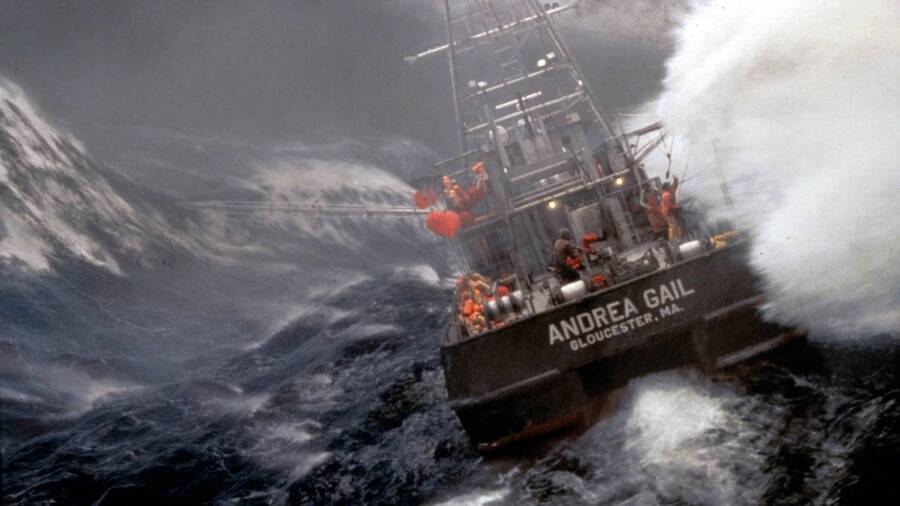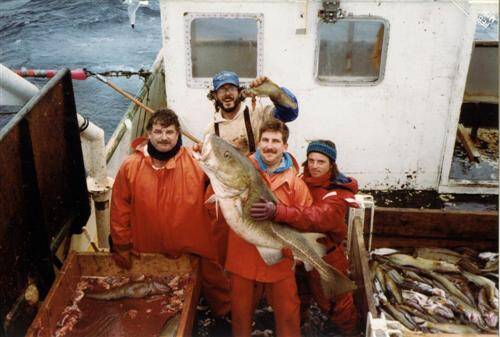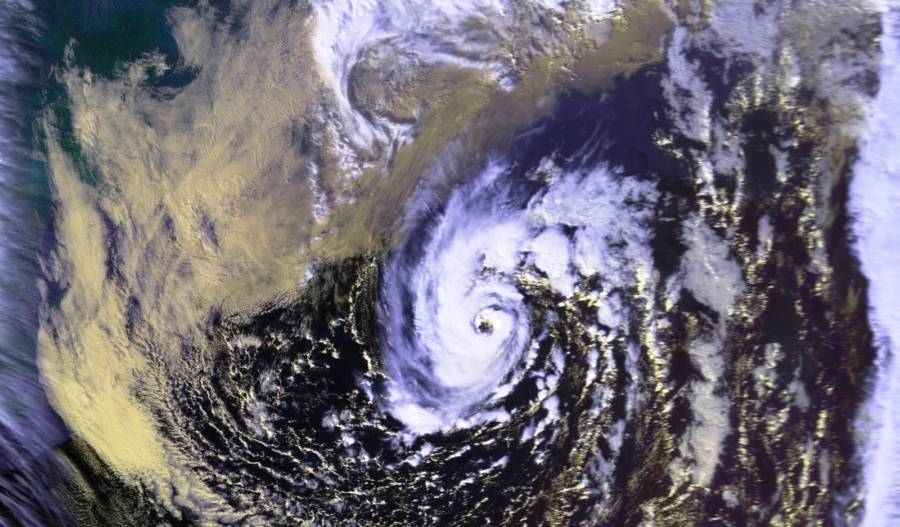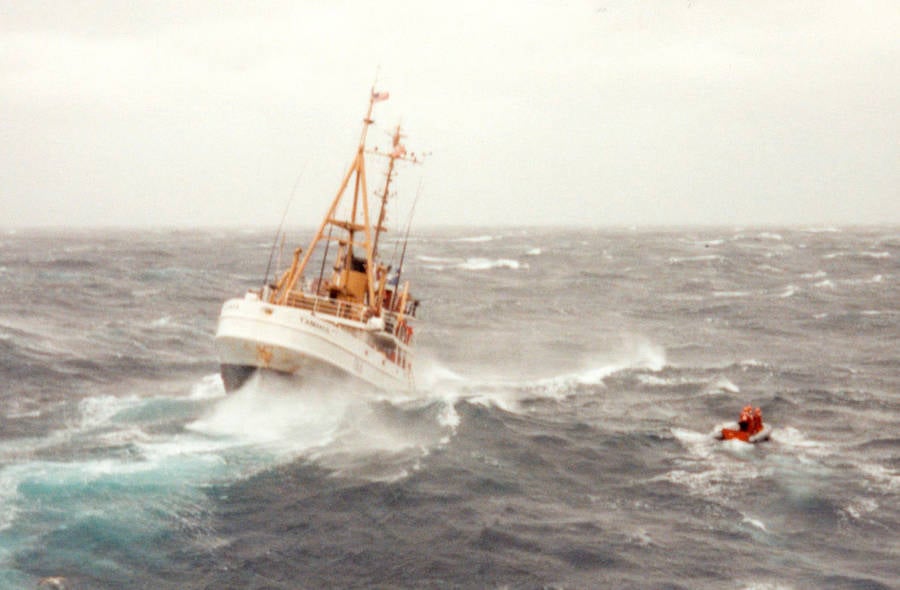Just before Halloween, the Andrea Gail and its crew of six fishermen were caught in what became known as the “Perfect Storm” of 1991 — and were never seen again.

Warner Bros. PicturesA shot of the Andrea Gail as it appears in the film The Perfect Storm.
On September 20, 1991, the Andrea Gail left port in Gloucester, Massachusetts for the Grand Banks of Newfoundland. The plan was to fill the hold with swordfish and return within a month or so, but that depended on the crew’s luck — and not long after the ship arrived at the Grand Banks, they realized they didn’t have much.
Then, on October 29, the 40th day of their extended commercial fishing trip, three devastating storms converged, sending waves as high as 100 feet and striking the Andrea Gail with winds reaching 92 miles per hour.
Of the six men on board the Andrea Gail that day, none of them made it home. A few weeks after the ship went missing, its emergency beacon washed ashore on Sable Island, off the Nova Scotian coast, but the vessel itself was never found.
The Andrea Gail Sets Sail
Like most fishermen, the six-man crew of the Andrea Gail would have preferred a quick voyage.
They wanted to get their fish, return to port, and go back to their families with a decent amount of money in their pockets. Every day they spent fishing without a catch meant another day out in the cold waters of the Atlantic.

chillup89/YoutubeThe Andrea Gail at port.
The Andrea Gail was a well-equipped ship. According to Outside, the boat had been fully rigged, ready for a long trip. On board, it was stocked with hundreds of miles of monofilament line, thousands of fishing hooks, and 10,000 pounds of bait. It was equipped with seven life preservers, plus six survival suits, a life raft, and an emergency beacon.
It should have been able to weather any storm. Its owner, Bob Brown — known as Suicide Brown among the locals, due to the risks he took as a young fisher — had taken the Andrea Gail on dozens of excursions before, and this one was shaping up to be no different for its new crew.
Captained by Frank “Billy” Tyne, a young and fearless captain who had braved many storms before, the Andrea Gail was seemingly more than prepared for anything the ocean could throw at it. Alongside Captain Tyne were David Sullivan, Alfred Pierre, Bobby Shatford, Dale Murphy, and Michael “Bugsy” Moran.
The six-man crew set sail aboard the Andrea Gail on Sept. 20, 1991, ready to haul back tons of swordfish and make, ideally, tons of cash. It took them a week to reach the Grand Banks, but once they’d reached their destination, they began casting their lines out immediately.

TwitterThe crew of the Andrea Gail.
No luck, though. As told in Gillian Houghton’s The Wreck of the Andrea Gail: Three Days of a Perfect Storm, the fish just weren’t biting, and to make matters worse, parts of the ship were starting to break down — notably, the ice machine, which meant that anything they did manage to catch was going to spoil quickly if they didn’t make it back to land as soon as possible.
Tyne decided that before that, to get home as soon as possible, they’d first have to travel farther away. The Andrea Gail set its course east toward Flemish Cap, another fishing ground where Tyne hoped they’d make a nice haul.
Unfortunately, all that awaited them was disaster.
The “Perfect Storm” Brews
As the men on the Andrea Gail were cursing their luck, a storm was brewing off the coast.
Some extreme weather patterns were coming together to create the ideal conditions for a massive nor’easter. Nor’easters are common in the region, but this was no common storm. Meanwhile, a hurricane was brewing in the Atlantic.

NOAA/ Wikimedia CommonsA satellite image of the storm.
Typically, late-season hurricanes like Hurricane Grace dissipate over land — but Grace never even made it to shore due to a massive cold front, known as an anticyclone, blocking the Eastern Seaboard. When Grace came up against this anticyclone, it literally bounced off of it and headed back out to sea.
Soon, Grace collided with a low-pressure system that had been developing over Quebec and traveling eastward off the Canadian Maritimes, causing a strange stall off the coast of Nova Scotia. It was at this conjunction point that the storms converged and began to grow rapidly, producing massive waves and gale-force winds. Once more, it reversed directions, heading back toward New England.
But back on board the Andrea Gail, things seemed to be turning around — Tyne’s decision to try Flemish Cap had paid off. The holds were filled with enough swordfish to earn every man on board a big paycheck.
On October 27, Captain Tyne decided to pack it in and head home. The next day, the Andrea Gail made contact with another ship fishing in the area, the Allison.
Around 6 p.m. on October 28, Tyne reported to the Allison that he and his crew were 130 miles north-northeast of Sable Island and already experiencing 80-knot winds.
“She’s comin’ on, boys,” he said, “and she’s comin’ on strong.”
The Loss Of The Andrea Gail
Gloucester Times reported that the Andrea Gail‘s last communication was with another ship called the Hannah Boden.
Linda Greenlaw, the captain of the Hannah Boden, remembered later, “I wanted a weather report, and Billy [Tyne] wanted a fishing report. I recall him saying, ‘The weather sucks. You probably won’t be fishing tomorrow night.”
It was the last anyone ever heard from the crew. The storm was building rapidly, with no word from the men at sea. After three days without any word from the ship, Bob Brown made the decision to list it as missing to the Coast Guard.

US Coast GuardA Coast Guard cutter at sea during the storm.
“Depending on the conditions and the amount of catch, they are usually out there a month,” Brown told the Boston Globe after the storm, as reported by Boston.com. “But what got me worried is that there were no communications for such a long time.”
By October 30, the day the ship was reported missing, people back on shore were getting their own taste of the storm. Wind gusts of 70 miles per hour were whipping across the surface of the sea, and waves some 30 feet high were crashing onto the shores.
The Boston Globe reported at the time that the winds “tossed [boats] like beach toys [in] the surf.” Houses were pulled off their foundations by the rising water.
By the time the storm was over, it had caused nearly $500 million in damage and 13 deaths.
Meteorologists remained divided about what exactly had caused this “perfect storm” to grow so suddenly before retrograding. At the time, the National Weather Service and Environment Canada concluded that it must have had something to do with the counter-clockwise spin of Hurricane Grace meeting with the clockwise swirl of the anticyclone. They believed that this collision created a funnel that caused it to rapidly increase in speed.
As it traveled westward, it gathered more moisture and energy from the dying hurricane, and grew increasingly vicious. The technical term for the event was a “midlatitude cyclone,” though most people who experienced it began to refer to it as the No Name Hurricane, since it was just as strong as any other hurricane, just without the designation.
Some have even taken to calling it the Halloween Gale, given that it struck the Eastern Seaboard on October 31.
That same day, the Coast Guard started a massive search for the crew of the Andrea Gail. There was no sign of the ship or the crew until November 5, when the ship’s emergency beacon washed ashore on Sable Island off the coast of Canada. Eventually, more debris turned up, but the crew and ship were never seen again.
Dramatizations Of The Andrea Gail‘s Disappearance
The story of the shipwreck was eventually told in a book by Sebastian Junger titled The Perfect Storm in 1997. In 2000, it was adapted into a movie with the same title, starring George Clooney.
In the movie, the Andrea Gail was swamped by a massive wave in the middle of the storm. In truth, no one is sure what happened to the ship or its crew.
“I think the book was true, well researched, and well written,” Maryanne Shatford, sister of missing crewman Bob Shatford, told Boston.com. “It was the movie that was too Hollywood. They wanted it to be a story more than it was between the characters.”
According to Linda Greenlaw, “My one gripe about The Perfect Storm movie was how Warner Brothers depicted Billy Tyne and his crew as making a very conscious decision to steam into a storm that they knew was dangerous. That is not what happened. The Andrea Gail was three days into their steam home when the storm hit.
“Whatever happened to the Andrea Gail happened very quickly.”
Next, read the true story of Tami Oldham Ashcraft and the movie ‘Adrift’. Then, learn the harrowing tale of John Paul Getty III’s kidnapping.






